Related Research Articles
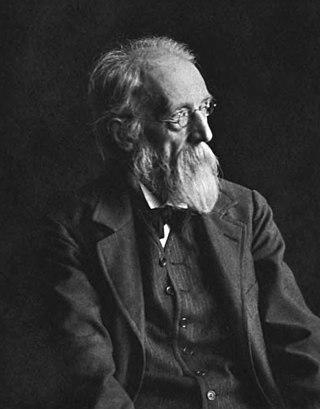
Theodor Nöldeke was a German orientalist and scholar, originally a student of Heinrich Ewald. His research interests ranged over Old Testament studies, Semitic languages and Arabic, Persian and Syriac literature. Nöldeke translated several important works of oriental literature and during his lifetime was considered an important orientalist. He wrote numerous studies and contributed articles to the Encyclopædia Britannica. He is sometimes credited with starting the higher criticism of the Qur’ān.

Edessa was an ancient city (polis) in Upper Mesopotamia, in what is now Urfa or Şanlıurfa, Turkey. It was founded during the Hellenistic period by King Seleucus I Nicator, founder of the Seleucid Empire. It later became capital of the Kingdom of Osroene, and continued as capital of the Roman province of Osroene. In Late Antiquity, it became a prominent center of Christian learning and seat of the Catechetical School of Edessa. During the Crusades, it was the capital of the County of Edessa.

Mar Awgin or Awgen, also known as Awgin of Clysma or Saint Eugenios, was an Egyptian monk who, according to traditional accounts, introduced Christian monasticism to Syriac Christianity. These accounts, however, are all of late origin and often contain anachronisms. The historicity of Awgin is not certain.
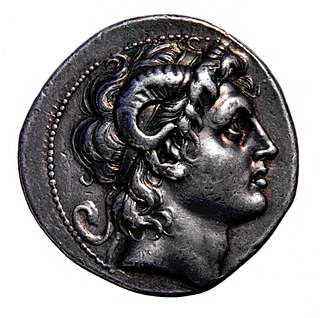
The story of Dhu al-Qarnayn is mentioned in Surah al-Kahf of the Quran. It has long been recognised in modern scholarship that the story of Dhu al-Qarnayn has strong similarities with the Syriac Legend of Alexander the Great. According to this legend, Alexander travelled to the ends of the world then built a wall in the Caucasus mountains to keep Gog and Magog out of civilized lands.

Dhu al-Qarnayn, appears in the Quran, Surah al-Kahf (18), Ayahs 83–101 as one who travels to east and west and sets up a barrier between a certain people and Gog and Magog. Elsewhere, the Quran tells how the end of the world will be signaled by the release of Gog and Magog from behind the barrier. Other apocalyptic writings predict that their destruction by God in a single night will usher in the Day of Resurrection.
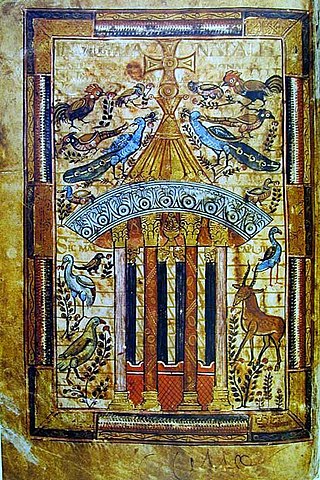
The Fountain of Life, or in its earlier form the Fountain of Living Waters, is a Christian iconography symbol associated with baptism and/or eucharist, first appearing in the 5th century in illuminated manuscripts and later in other art forms such as panel paintings.

Syriac literature is literature in the Syriac language. It is a tradition going back to the Late Antiquity. It is strongly associated with Syriac Christianity.

The Alexander Romance is an account of the life and exploits of Alexander the Great. The Romance describes Alexander the Great from his birth, to his succession of the throne of Macedon, his conquests including that of the Persian Empire, and finally his death. Although constructed around an historical core, the romance is mostly fantastical, including many miraculous tales and encounters with mythical creatures such as sirens or centaurs.

The Gates of Alexander, also known as the Caspian Gates, are one of several mountain passes in eastern Anatolia, the Caucasus, and Persia separating the Greco-Roman world from the Persian world. They are often imagined as an actual fortification, or as a symbolic boundary separating the civilized from the uncivilized world. The original Gates of Alexander were just south of the Caspian Sea, at Rhagae, where Alexander crossed while pursuing Darius III. The name was transferred to passes through the Caucasus, on the other side of the Caspian, by the more fanciful historians of Alexander.
The Cave of Treasures, sometimes referred to simply as The Treasure, is an apocryphal and pseudoepigraphical work, that contains various narratives related to the Christian Bible. It was written in the Syriac language, approximately at the end of the 6th, or at the beginning of the 7th century. Its authorship was traditionally attributed to Ephrem of Edessa, but modern scholarly analyses have shown that the true author was some other person, who also lived in Upper Mesopotamia, but much later.
Apocalypse of Pseudo-Ephraem is a pseudoepigraphical text attributed to the church father Ephrem the Syrian. Two distinct documents have survived — one in Syriac and one in Latin. The Syriac document focuses on apocalyptic themes through the lens of Middle Eastern events which took place at the time it was written. Confusion exists around the Pseudo-Ephraem text primarily because of its doubtful authorship and date, differences between the Syriac and Latin versions, the small number of extant manuscripts, and the limited study that has been conducted of the text. Additionally, many extant works have been ascribed to Ephrem despite his authorship of these documents being doubtful. This has created significant difficulty in the area of textual criticism.

Odontotyrannos, also odontotyrannus or dentityrannus ("tooth-tyrant") is a mythical three-horned beast said to have attacked Alexander the Great and his men at their camp in India, according to the apocryphal Letter from Alexander to Aristotle and other medieval romantic retellings of Alexandrian legend.

The vast conquests of the Macedonian king Alexander the Great quickly inspired the formation and diffusion of legendary material about his deity, journeys, and tales. These appeared shortly after his death, and some may have already begun forming during his lifetime. In the third century AD, an anonymous author writing in the name of Alexander's court historian Callisthenes authored the Greek Alexander Romance. This text would spawn a genre of literature about the legends and exploits of Alexander across centuries, going through over one hundred versions in premodern times and appearing in almost every language in both European and Islamic worlds.

Christina, born Yazdoi, was a Sasanian Persian noblewoman and Christian venerated after her death as a virgin martyr.
The Syriac Alexander Legend, is a Syriac prose recension in the tradition of the Greek Alexander Romance, although Theodor Nöldeke has influentially argued that the Legend was translated from a now-lost Middle Persian (Pahlavi) original as opposed to the Greek. It was composed in the Syriac language, perhaps in the region of northern Mesopotamia. It had a strong influence on later apocalyptic literature, such as can be seen in the Apocalypse of Pseudo-Methodius. It is also the first work to fuse the motifs of Alexander's gate, an apocalyptic incursion, and the barbarian tribes known as Gog and Magog. Historically, the Syriac Alexander Legend has been dated to 629/630 shortly after the conclusion of the Byzantine–Sasanian War of 602–628, though some more recent works have proposed 6th-century dates for the composition and tradition.
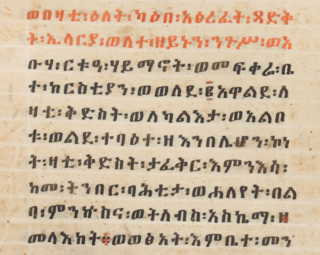
The Legend of Hilaria is a Coptic romance, possibly a Christian version of the pagan Tale of Bentresh. It was written between the 6th and 9th centuries AD. During the Middle Ages, it was translated into Syriac, Arabic and Ethiopic. It tells the tale of Hilaria, daughter of the Roman emperor Zeno, who disguised herself as a man to become a monk and later heals her sister of an ailment. The tale was incorporated into the synaxaries of the Oriental Orthodox churches, and Hilaria came to be celebrated as a saint.
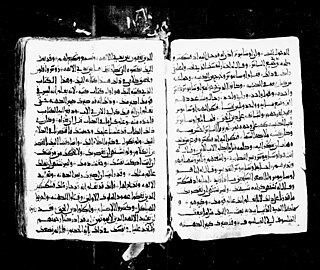
The Julian Romance is fictionalized prose account of the reign of the Roman emperor Julian the Apostate. It was written sometime between Julian's death in 363 and the copying of the oldest known manuscript in the sixth century. It was probably written in Edessa in Syriac, the language of all surviving copies. An Arabic adaptation had been made by the tenth century.

The Apocalypse of Pseudo-Ezra is a set of visions of the end times composed in the Syriac language sometime between the 7th and 12th centuries and attributed to Ezra. It is a short text of about seven manuscript pages. It recapitulates history in the form of prophecy using obscure animal imagery. Written to console Christians living under Islamic rule, it predicts the end of such rule in the Near East.

The Horns of Alexander represent an artistic tradition that depicted Alexander the Great with two horns on his head, a form of expression that was associated originally as the Horns of Ammon. Alexander's horns came with connotations of political and/or religious legitimacy, including indications of his status as a god, and these representations of Alexander under his successors carried implications of their divine lineage or succession from his reign. Mediums of expression of the horns of Alexander included coinage, sculpture, medallions, textiles, and literary texts, such as in the tradition of the Alexander Romance literature. Rarely was anyone other than Alexander depicted with the two horns as this was considered unique to his imagery.
The Cause of All Causes, also called the Book of the Acknowledgement of Truth, is an anonymous Syriac encyclopedia written sometime between the 10th and 12th centuries.
References
Citations
- 1 2 Reinink, Gerrit J. (2003). "Alexander the Great in Seventh-Century Syriac 'Apocalyptic' Texts". Byzantinorossica. 2: 150–178.
- ↑ Nöldeke, Theodor (1890). Beiträge zur geschichte des Alexanderromans. University of Michigan. Wien, F. Tempsky. pp. 30–31.
- ↑ Bousset, Wilhelm (1900). "Beiträge zur Geschichte der Eschatologie". Zeitschrift für Kirchengeschichte (in German). 20 (2).
- 1 2 Tesei 2023, p. 22.
- ↑ E. A. Wallis Budge. The History of Alexander the Great, being the Syriac version of the Pseudo-Callisthenes. pp. 163–200.
- 1 2 Reynolds, Gabriel Said (2018). The Qur'an and the Bible: text and commentary. New Haven, CT: Yale University Press. pp. 463–465. ISBN 978-0-300-18132-6.
- ↑ Crone, Patricia (2016). Islam, the Ancient Near East and Varieties of Godlessness: Collected Studies in Three Volumes, Volume 3. Brill. pp. 67–68.
Sources
- Tesei, Tommaso (2023). The Syriac Legend of Alexander's Gate. Oxford University Press.